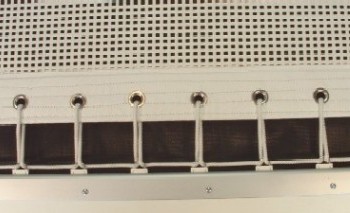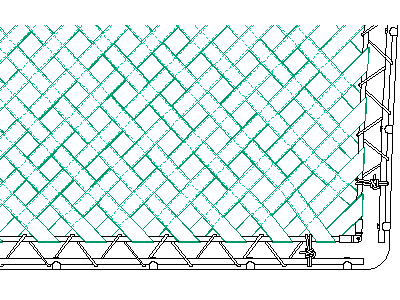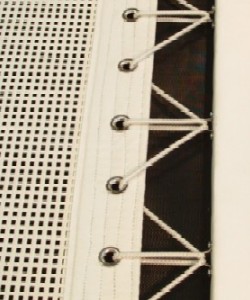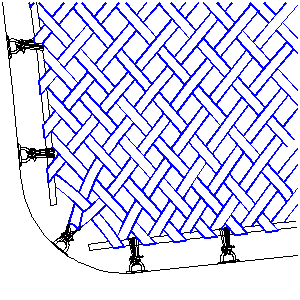Line
The Perpendicular and Alternating patterns will use 1 continuous line
for each side of the net. This line should be tied off at each end with
3 half hitches or a similar knot that can be untied under tension (not
with a bowline or stopper knot), which will make it possible to adjust
the net tension occasionally. The preferred line would be a 1/4" braided
polyester line with a core. The breaking strength of the line should
be over 1,000 lbs so if you need to use 3/16" line it would be recommended
to go to a stronger fiber such as spectra. For individual lashings you
can achieve the same strength with multiple wraps of the line, so an
1/8" cord with a breaking strength of 300 lbs should have at least 3-1/2
wraps to equal 1 wrap of 1000 lb line, however if the spacing between
lashings is large, more wraps should be used. All of these lines will
deteriorate with exposure to sunlight, and their susceptibility to chaffing
will increase with age. Lacing lines should be monitored routinely for
signs of wear and replaced when necessary.

|
 |
Perpendicular Lacing
This is the preferred method of lacing battens to fixed
or sliding attachments, where the lacing points are less than 10" apart.
There is minimal chance of line chafing in the hardware and the 90°
angle of the line to the batten provides maximum tension to the net.
This pattern will work with a minimal lacing gap of 2". The Attachment
points on the boat must be large enough for the line to pass through
twice. If you are using sliding attachments, the first and last lacing
slide must be locked In place or the line must tie off to a fixed point
near the corner. For added security one of the wraps near the midpoint
can be lashed tight with a small cord to prevent unlacing in the event
of a line breakage.

Alternate Lacing
An Alternating or Zig-Zag pattern will work with lacing point spacing
less than 6" and a lacing gap of 3" . This is the simplest method and
the easiest to tension as the line makes the fewest bends. There will
be some movement in the line against the lacing points with this pattern,
so there is a greater chance of chaffing. This is the method to use
if you are lacing around an offset bar or tube or beam.

Double Lacing
Double lacing is a combination of alternating and perpendicular. Its
main use would be for nets with grommet borders lacing to fixed attachment
points where the spacing is over 6". We do not recommend spacing
grommets at more than 6" so this method allows grommets to be
spaced at 1/2 the attachment point spacing and still have all of the grommets
supported.

Individual Lashings
The further apart the lacing points the greater the tension on each
point will need to be. If your lacing points are further apart than
10" you will need to individually lash each one with multiple wraps
of a small diameter line in order to get adequate tension on the net.
This method has the added benefit off greater security as each lacing
point line is independent of the others.
|